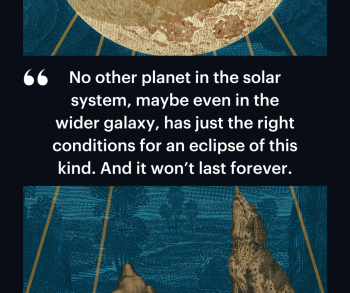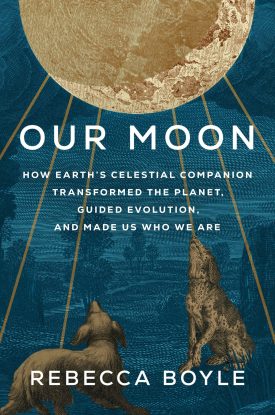To commemorate today’s solar eclipse, we interviewed science writer Rebecca Boyle about her new book Our Moon: How Earth’s Celestial Companion Transformed the Planet, Guided Evolution, and Made Us Who We Are.
Rebecca shares her thoughts on the future of the moon, what is so important about the solar eclipse from a human perspective, and the solar eclipse a hundred years ago that ended up “proving” Einstein’s theory.
You can an excerpt from this fascinating book here.

1. What does the upcoming total eclipse mean to you?
A total eclipse is a chance to see, and feel, the deep connection we share with the rest of the solar system. You can experience something similar on a very dark night, when the stars reveal themselves and you feel as though you are floating in space. But only during a total eclipse can you see the inner solar system, see the sun as an entity, see the presence of the Moon in the absence of the Sun. I also can’t help but be amazed by the incredible cosmic coincidence that the Sun and Moon seem to be the same size in the sky. Although the Sun is 400 times larger than our Moon, it is also 400 times more distant from us, so to our eyes, they are the same size. And this only happens right now, right here. No other planet in the solar system, maybe even in the wider galaxy, has just the right conditions for an eclipse of this kind. And it won’t last forever. The Moon is slowly moving away from us, thanks to tidal interactions between Earth and the Moon, and eventually it will be too far away to totally eclipse the Sun.

2. What do we take for granted about our Moon?
I think the most important thing we take for granted is its influence over our biology, and the biological evolution of everything else that lives on this planet. I didn’t realize, until writing this book, the extent to which the Moon is captain of life’s rhythms. It may have been what dragged primitive life up from the seafloor to encounter the Sun for the first time; it probably is why our vertebrate ancestors walked on land for the first time, instead of staying forever consigned to the sea. Even today, the Moon directs the reproductive cycles of animals and plants, and influences human biology through sleep and even certain behaviors.
3. Is there a particular solar eclipse (or a human reaction to a solar eclipse) that you find particularly fascinating? Why?
I love eclipses that teach us something new. I am partial to a couple different ones in particular. The first and maybe less well-known is an annular eclipse over Athens in
One of my favorite modern eclipses is from May 1919, which physicists used to “prove” the theory of general relativity. Einstein’s theory of gravity is really groundbreaking, and fundamental to our lives today — without special relativity and general relativity, we would not have accurate GPS satellite measurements, for instance. But when he proposed it, many physicists thought it was nuts. It took a solar eclipse to prove it. The central argument of Einstein’s general relativity is that huge objects bend the space around themselves. If this is true, then light, too, would have to follow that bend. The Sun is a huge object, so a good way to test this theory would be to watch how the Sun warps the space around it, shifting the appearance of background stars. But normally the Sun is too bright to make that measurement — you need a solar eclipse. In 1919, two teams of astronomers used a total eclipse to measure a star cluster called the Hyades, which was behind the Sun at the time. When they compared the light of the Hyades to previous measurements, the stars were misaligned, showing that Einstein was right.
4. What is something about lunar history that should be more widely known?
One of my favorites is the fact that Galileo Galilei was not actually the first person to observe the Moon through a telescope, or to record his observations. That honor goes to Thomas Harriot, an English astronomer and mathematician, who did it several months before Galileo. But Galileo was trained as a painter, and did a much better job conveying what he saw. He also was more inclined to seek attention. This is in part because Harriot was already wary of the spotlight, having weathered accusations about his involvement with people who planned the infamous Gunpowder Plot to blow up Parliament in 1605.
5. What do you think the future of moon landings and/or moon focused space missions are?
I expect to see a regular cadence of Moon landings in the coming decade, from commercial companies, private enterprise, various countries, and of course by NASA. The Artemis program, which aims to send the first woman astronaut to the lunar surface before this decade is out, will ramp up in the next couple years — but lots of progress is already under way. I think people are not ready for how much is going to be happening on the Moon in the next few years — and more importantly, people are not ready for how much this is going to change the Moon, and our relationship to it, maybe forever.
It’s important to keep in mind that the Moon has no natural defense mechanisms, or ways to restore itself. Earth does; we experience this through rain, wind, tide, climate, and plate tectonics, like the recent devastating earthquake in Taiwan. The Earth recycles and consumes itself. The Moon does not. Anything we do to it now will last forever. This is a huge responsibility to everyone who came before us, and to everyone who will come after us to live here beside the Moon. I hope people think about this as we seek to go back for good.
